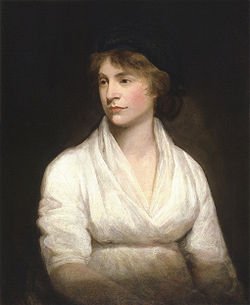
Mary Wollstonecraft was born on 27 April 1759 in Spitalfields, London. She grew up in a difficult family situation. Her father was often violent and prone to drunken moods, especially after losing money in ill-judged investments. Mary spent considerable time looking after her sisters and mothers. However, in 1778, she tired of domestic life and decided to take a job as a lady’s companion to Sarah Dawson. This proved a difficult experience as she didn’t get on with the old lady. However, around this time, she became acquainted with Fanny Blood, who played an important role in widening Mary’s horizons and ideas. The two became very close and Fanny Blood’s untimely death in 1785 was quite a shock to Mary.
For a while, Mary worked as a governess in a large Irish family. She had a talent for teaching but took a dislike to Lady Kingsborough. To Mary, Kingsborough was the antithesis of an ideal woman. In Lady Kingsborough, she saw a woman with no real independence, but primarily concerned with superficial appearances and pleasing men. Mary later developed her thoughts on the concept of a good wife.
“To be a good mother — a woman must have sense, and that independence of mind which few women possess who are taught to depend entirely on their husbands. Meek wives are, in general, foolish mothers; wanting their children to love them best, and take their part, in secret, against the father, who is held up as a scarecrow. “
– Mary Wollstonecraft, A Vindication of the Rights of Woman (1792)
This experience fermented a desire to become a writer; Mary returned to London where she became acquainted with luminaries such as Thomas Paine, William Godwin and Joseph Johnson. In London, she became more aware of new strains of political and philosophical ideas; the late eighteenth century was an era of change. The old ‘divine rights’ of kings was being replaced with greater faith in human reason and liberty; this sea change in attitudes best exemplified by the French Revolution.
Like many radicals, Mary was initially enthused by the French revolution. In 1790, she wrote an influential pamphlet Vindication of the Rights of Men (1790). This sought to defend the principles of the French Revolution against Edmund Burke’s conservative critique. This helped establish Mary as a leading liberal writer; at the time, it was rare for a woman to have such prominence in literary circles.
Vindication of the Rights of Women
Shortly after the Vindication of the Rights of Men (1790), Mary wrote A Vindication of the Rights of Women (1792). This was ground-breaking work, as it proposed women were the equal of men. Wollstonecraft contended it was only the lack of education for women that meant they seemed to be intellectually inferior.
Source
Plagiarism is the copying & pasting of others work without giving credit to the original author or artist. Plagiarized posts are considered spam.
Spam is discouraged by the community, and may result in action from the cheetah bot.
More information and tips on sharing content.
If you believe this comment is in error, please contact us in #disputes on Discord
Downvoting a post can decrease pending rewards and make it less visible. Common reasons:
Submit